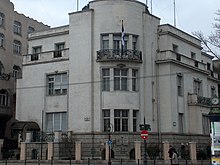Serbs of Hungary

Embassy of Serbia (“Serbian house”) across the Heroes Square in Budapest
|
|
| Total population | |
|---|---|
| 7,210 (2011) | |
| Regions with significant populations | |
| Budapest, Szentendre, Lórév (Lovra) | |
|
|
1,376 |
|
|
1,292 |
|
|
606 |
|
|
412 |
| Religion | |
| Serbian Orthodox Church | |
| Related ethnic groups | |
| Croats of Hungary | |
The Serbs in Hungary (Hungarian: Magyarországi szerbek, Serbian: Срби у Мађарској / Srbi u Mađarskoj) are recognized as an ethnic minority, numbering 7,210 people or 0.1% of the total population (2011 census). The number of Serbs in Hungary has drastically diminished; in the 16th, 17th and 18th centuries large Serb communities existed throughout Hungary, notably in Buda (western Budapest), Baja, Szentendre and Szeged. The Serb community in the territory of present-day Hungary has its origin in migrations from the territory of medieval Serbian states during and after the Ottoman conquest of these states. Matthias Corvinus and his successors are known to have welcomed Serbs from the other side of the Danube, giving the exiled military commanders fiefdoms to rule and defend from the Ottomans. After the dissolution of Austro-Hungarian Monarchy in 1918 and after new borders were defined by the Treaty of Trianon in 1920, only a small fraction of ethnic Serbs remained within the borders of post-Trianon Hungary.
The presence of Serbs in the territory of present-day Hungary date from the Middle Ages. The mother of the Hungarian king Géza II (1141-1162) was Helena of Raška, a daughter of the great župan of Raška, Uroš I. During the rule of Géza II, her brother Beloš Vukanović was a palatine of the Kingdom of Hungary.
...
Wikipedia
